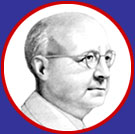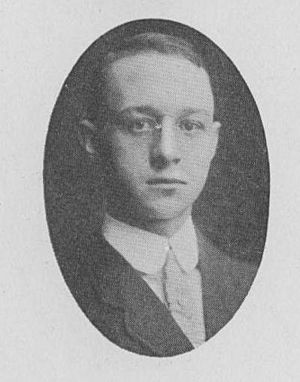Clarence Birdseye facts for kids
Quick facts for kids
Clarence Birdseye
|
|
|---|---|
 |
|
| Born |
Clarence Birdseye
December 9, 1886 Brooklyn, New York, US
|
| Died | October 7, 1956 (aged 69) New York City, US
|
| Occupation |
|
| Known for | Establishing the modern frozen food industry |
Clarence Birdseye (December 9, 1886 – October 7, 1956) was an American inventor and entrepreneur. He is known as the founder of the modern frozen food industry. He started the famous frozen food company, Birds Eye. One of his key inventions was the double belt freezer.
Birdseye was one of nine children. He grew up in Brooklyn, New York. He later attended Amherst College. He began his science career with the U.S. government. A book about his life was published many years after his death.
Contents
Early Life and Discoveries
Clarence Birdseye was the sixth of nine children. His parents were Clarence Frank Birdseye and Ada Jane Underwood. He spent his early years in Brooklyn, New York. From a young age, Birdseye loved natural science. He was especially interested in taxidermy, which is preparing, stuffing, and mounting animal skins. He taught himself this skill by mail. When he was eleven, he even advertised his taxidermy lessons.
When he was fourteen, his family moved to Montclair, New Jersey. Birdseye graduated from Montclair High School. He then went to Amherst College, where his father and older brother had studied. He was very good at science. His college friends nicknamed him "Bugs" because he loved collecting insects.
After his first year of college, Birdseye worked for the United States Department of Agriculture (USDA). He was an "assistant naturalist" in New Mexico and Arizona. The USDA wanted to help farmers control animal predators like coyotes.
In 1908, Birdseye left college after his second year due to family reasons. He was hired again by the USDA. This time, he surveyed animals in the American West. He also worked with an entomologist (insect scientist) named Willard Van Orsdel King. In Montana, they caught many small mammals. From these animals, King found thousands of ticks. This research helped show that ticks caused Rocky Mountain spotted fever. This was a big discovery.
Freezing Food in Labrador
From 1912 to 1915, Birdseye worked in Labrador, which is now part of Canada. Here, he became very interested in how to preserve food by freezing it. He bought land and built a ranch to raise foxes. The local Inuit people taught him how to ice fish under very thick ice.
In extremely cold weather (about -40 °C), he noticed something amazing. The fish he caught froze almost instantly. When he thawed them later, they still tasted fresh. He realized that the frozen seafood sold in New York was not as good. He understood that this knowledge about fast freezing could be very valuable. This experience in Canada inspired his new food preservation methods.
The Science of Fast Freezing
When food freezes slowly, large ice crystals form inside its cells. When the food thaws, these crystals damage the cells. This makes the food mushy or dry. But with rapid freezing, at much colder temperatures, ice crystals have less time to form. This causes much less damage to the food.
In 1922, Birdseye experimented with freezing fish. He then started his own company, Birdseye Seafoods Inc.. He froze fish fillets using very cold air at -43 °C (-45 °F). However, his company went out of business in 1924. People were not interested in the product yet.
That same year, he created a new and better way to quick-freeze food for sale. He packed fish into cartons. Then, he froze the contents between two very cold surfaces under pressure. Birdseye created the General Seafood Corporation to promote this new method.
Developing the Frozen Food Industry
In 1925, General Seafood Corporation moved to Gloucester, Massachusetts. There, they sold Birdseye's newest invention: the double belt freezer. This machine used cold saltwater (brine) to chill two stainless steel belts. Packaged fish traveled on these belts, freezing very quickly. This invention was given US Patent #1,773,079. Many people consider this patent the start of today's frozen food industry.
Birdseye also patented other machines that could cool food even faster. In 1927, he patented the multiplate freezing machine. This machine was used for freezing food for many decades.
The Birds Eye Brand is Born
In 1929, Birdseye sold his company and patents for $22 million. This amount would be about $335 million today. The buyers were Goldman Sachs and the Postum Company. This company later became General Foods Corporation. General Foods then created the Birds Eye Frozen Food Company.
Birdseye continued to work with the company. He kept developing new frozen food technologies. In 1930, the company started selling frozen foods in 18 stores. These stores were around Springfield, Massachusetts. They wanted to see if people would buy quick-frozen foods. The first products included 26 items. These items were frozen meats, spinach, peas, fruits, berries, oysters, and fish fillets.
Consumers really liked these new products. This moment is seen as the true beginning of retail frozen foods. The "Birds Eye" name is still a leading frozen-food brand today. In 1949, Birdseye received the Institute of Food Technologists' Babcock-Hart Award. In 2005, Birdseye was added to the National Inventors Hall of Fame.
Death
Clarence Birdseye died on October 7, 1956. He was 69 years old. He passed away from a heart attack at the Gramercy Park Hotel. His body was cremated. His ashes were scattered in the sea near Gloucester, Massachusetts.
Legacy
In 2012, a book about Birdseye's life was published. It was called Birdseye: The Adventures of a Curious Man by Mark Kurlansky.
Birdseye's Food-Related Inventions
- Method of preserving piscatorial products, 1924. (How to preserve fish products)
- Brining machine, 1925. (A machine for treating food with salt water)
- Method in preparing foods and the product obtained thereby, 1926. (A way to prepare foods and the resulting product)
- Refrigerating apparatus; 1930, 1931, 1932, 1933, 1935. (Machines for cooling)
- Method of packaging fruit juices, 1930. (How to package fruit juices)
- Bin for storage of fish, 1931. (A container for storing fish)
- Refrigerating apparatus and method of refrigerating food products, 1931. (A cooling machine and method for cooling food)
- Fish scaling device, 1933. (A tool for removing fish scales)
- Consumer package of meat products, 1933. (A package of meat for shoppers)
- Food product and method of preparing the same, 1934. (A food item and how to make it)
- Freezing and packaging food products, 1934. (How to freeze and package food)
- Method and apparatus for freezing food products, 1935. (A way and machine for freezing food)


